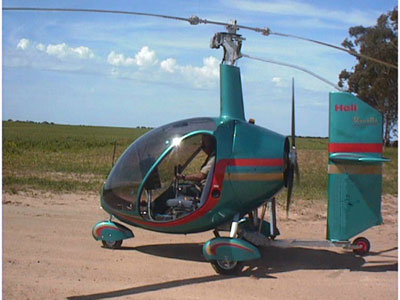
 |
|
Picture courtesy of
www.ufo-helithruster.com
|
To fully understand the physics of an autogyro, one must know what it is. An autogyro is an aircraft, similar to a modern helicopter in appearance, but with a few major dissimilarities. It, like a helicopter, uses an overhead rotor as its main source of lift. The rotor on an autogyro, however, is freely rotating, meaning it is not powered by any engine, and therefore applies no rotational force, or torque, on the machine. This nullifies the need for a tail rotor like that of a helicopter's because there is no need to stabilize the fuselage from twisting. Because of the fact that the rotor does not spin on its own to give itself thrust like a helicopter, it makes for the need of another form of forward propulsion. This comes in the form of a propeller, like that on an airplane, to propel the machine forward, which makes air to pass though the overhead rotor, causing it to spin and create lift. The faster the machine goes, the more lift the rotor creates.
Autogyros can fly very slow, sink vertically down, take off vertically up if a jump-start is added, and even fly somewhat backwards. Something they cannot do, however, is hover. They can "hover against the wind" if a small breeze is present, but do not have the capabilities of actual hovering. Autogyros are excellent at maneuvering and can land on small platforms and oilrigs. Autogyros are generally small in comparison to helicopters, or any other type of aircraft. Hobbyists, the main producers of autogyros, typically make them in the range of 200-2000 pounds. This is extremely small in comparison to their fixed-winged, and forcefully rotating cousins. Because of this, they can traverse into very tight spots, slowly, and quietly, making them a great candidate for military reconnasissance and drop-offs. In addition, autogyros are some of the safe, if not the safest type of aircraft. Even if the propulsory engine is shot or fails, the aircraft will autorotate down the ground, still straight up, slowly so that the pilot should still be in complete control, alive and well. This is particularly helpful, in cases where one runs out of fuel during a trip, or mission in the case of a military operation gone wrong. Even if the fuel ran out, the aircraft could still find a spot to land in time, which would be impossible with an airplane, and extremely difficult, if not impossible, with a helicopter.
Higher end autogyros have cruising speeds exceeding 130mph, an average climb rate of 1,500ft/m, and an average final altitude of 14,000 feet, depending on the make of the aircraft. There are gyros that have values exceeding these, but most do not, because the makers are just having fun, rather than analyzing every thing in the system to make it optimal. Also most aircraft do not have flying speeds that are this low in magnitude without stalling.